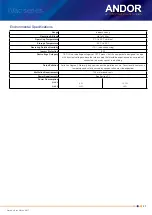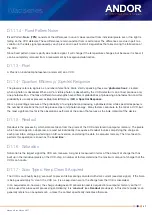
Version 2.0 rev 26 Jan 2017
35
iVac series
D1.8 - Dark Signal
Dark signal, a charge usually expressed as a number of electrons, is produced by the flow of dark current during the
exposure time. All CCD’s produce a dark current, an actual current that is measurable in (typically tenths of) milliamps
per pixel. The dark signal adds to your measured signal level, and increases the amount of noise in the measured signal.
Since the dark signal varies with temperature, it can cause background values to increase over time. It also sets a limit
on the useful exposure time.
Reducing the temperature of the CCD reduces dark signal (typically, for every 7ºC that temperature falls, dark signal
halves). CCD readout noise is low, and so as not to compromise this by shot noise from the dark signal, it is important
to cool the detector to reduce the dark signal. If you are using an exposure time of less than a few seconds, cooling the
detector below 0ºC will generally remove most of the shot noise caused by dark signal.
D1.9 - Detection Limit
The Detection Limit is a measure of the smallest signal that can be detected in a single readout. The smallest signal is
defined as the signal whose level is equal to the noise accompanying that signal, i.e. a signal to noise ratio (S/N) of unity.
Sources of noise are:
•
Shot noise of the signal itself
•
Shot noise of any dark signal
•
Readout noise
If the signal is small, we can ignore its shot noise.
Furthermore, if a suitably low operating temperature and short exposure time can be achieved, the lowest detection limit
will equal the readout noise.
d1.10 - e
xposURe
t
iMe
Exposure Time
is the period during which the CCD collects light prior to readout.
D1.11 - Noise
Noise is a complex topic, the full exploration of which is beyond the scope of this glossary. Noise may, however, be
broken down into two broad categories as follows:
•
Pixel Noise
•
Fixed Pattern Noise
These two categories are described in the paragraphs that follow.




















